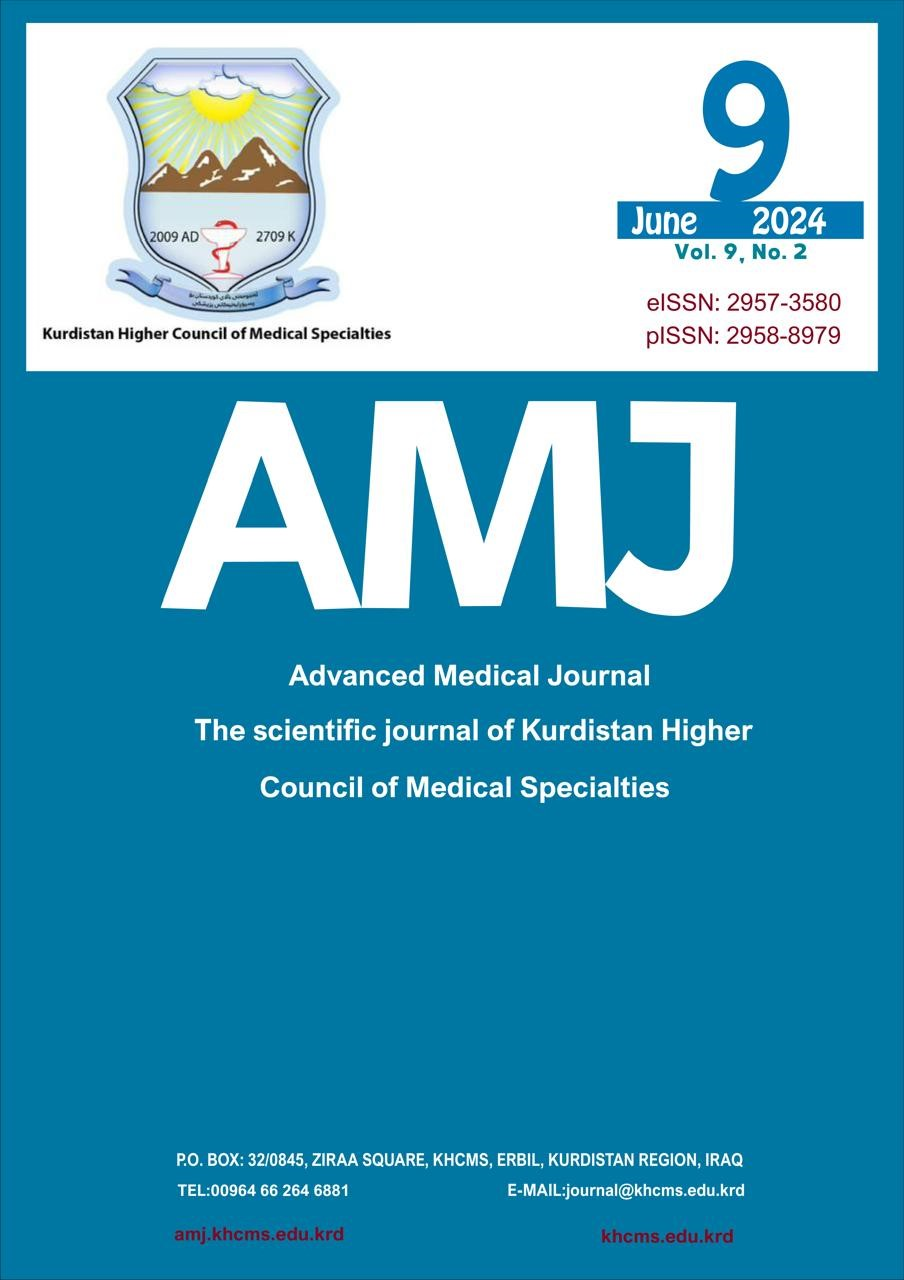Programmed death ligand I (PDL-1) Expression in renal cell carcinoma: A retrospective cohort study
DOI:
https://doi.org/10.56056/amj.2024.270Keywords:
PD-1, PDL-1, Renal cell carcinomaAbstract
Background and objectives: Inhibition of programed death -1and programed death ligand-1 pathway enhances antitumor activity of T lymphocytes, therefore, provides a new strategy for tumor treatment utilizing immunotherapy. The aim of this study to assess the frequency of programed death ligand-1 expression in renal cell carcinoma by using the immunohistochemistry and to correlate the results the clinicopathologic parameters.
Methods: This is a cross sectional retrospective study performed in Duhok City from 2017-2022 on fifty-four formalin fixed paraffin embedded blocks of nephrectomy specimens diagnosed as renal cell carcinoma and collected from central lab of Duhok and some private labs. Two sections were prepared from each block, one section was stained with hematoxylin and eosin for histological analysis and the other one was used for immunohistochemical assessment of programed death ligand-1then the results were correlated with various clinicopathological parameters.
Results: Programed death ligand -1; membranous expression was positive in 19 cases (35.2%) of renal cell carcinoma out of 54 cases. There was no significant correlation between programed death ligand -1 expression and age (p= 0.991), gender (p= 0.272), multifocality (p= 0.607), tumor size (p= 0.796), histological subtype (p= 0.107), tumor stage (p= 0.546), nuclear grade (p= 0.781), surgical margins involvement (p= 0.119) and lymphovascular invasion (p= 0.4), but there was statistically significant correlation with nodal metastases (p= 0.039).
Conclusion: Programmed death ligand -1/ Combined positive score was ?1 in about one third (35.2%) of renal cell carcinoma cases and this result can be utilized for the provision of immune checkpoint inhibitor (ICIs), regardless the age, gender, histological type, stage, nuclear grade, and the presence of lymphovascular invasion (LVI).
Downloads
References
Makino T, Kadomoto S, Izumi K, Mizokami A. Epidemiology and Prevention of Renal Cell Carcinoma. Cancers. 2022 ;14(16):4059.
Athanazio DA, Amorim LS, da Cunha IW, et al. Classification of renal cell tumors–current concepts and use of ancillary tests: recommendations of the Brazilian Society of Pathology. Surg Exp Pathol. 2021 ;4(1):1-21.
World Health Organization (WHO). Global Health Estimates 2020: Deaths by Cause, Age, Sex, by Country and by region, 2000–2019; WHO: Geneva, Switzerland, 2020.
Majidpoor J, Mortezaee K. Interleukin-2 therapy of cancer-clinical perspectives. Int Immunopharmacol. 2021; 98:107836.
Siegal R, Miller KD, Jemal A. Cancer statistics, 2012. Ca Cancer J Clin. 2014; 64(1):9-29.
Schottenfeld D, Fraumeni Jr. Cancer epidemiology and prevention. 3rd edition. Oxford university press Inc. Oxford; 2006.
Kumar B, Ghosh A, Datta C, Pal DK. Role of PDL1 as a prognostic marker in renal cell carcinoma: a prospective observational study in eastern India. Ther Adv Urol. 2019; 11:1756287219868859.
Warren AY, Harrison D. WHO/ISUP classification, grading and pathological staging of renal cell carcinoma: standards and controversies. World J Urol. 2018; 36:1913-26.
Reuter VE, Argani P, Zhou M, Delahunt B. ISUP Immunohistochemistry in Diagnostic Urologic Pathology Group. Best practices recommendations in the application of immunohistochemistry in the kidney tumors: report from the International Society of Urologic Pathology consensus conference. Am J Surg Pathol. 2014 ;38(8): e35-49.
Scherr AJ, Lima JP, Sasse EC, Lima CS, Sasse AD. Adjuvant therapy for locally advanced renal cell cancer: a systematic review with meta-analysis. BMC cancer. 2011 ;11(1):1-7.
Escudier B. Emerging immunotherapies for renal cell carcinoma. Ann Oncol. 2012 ;23: viii35-40.
Ishida Y, Agata Y, Shibahara K, Honjo T. Induced expression of PD?1, a novel member of the immunoglobulin gene superfamily, upon programmed cell death. EMBO J. 1992 ;11(11):3887-95.
Leite KR, Reis ST, Junior JP, et al. PD-L1 expression in renal cell carcinoma clear cell type is related to unfavorable prognosis. Diagn Pathol. 2015; 10(1):1-6.
Walter B, Gil S, Naizhen X, et al. Determination of the expression of PD-L1 in the morphologic spectrum of renal cell carcinoma. J Cancer. 2020;11(12):3596.
Thompson RH, Dong H, Lohse CM, et al. PD-1 is expressed by tumor-infiltrating immune cells and is associated with poor outcome for patients with renal cell carcinoma. Clin Cancer Res. 2007 ;13(6):1757-61.
Qin T, Zeng YD, Qin G, et al. High PD-L1 expression was associated with poor prognosis in 870 Chinese patients with breast cancer. Oncotarget. 2015 ;6(32):33972.
Rosenbaum MW, Bledsoe JR, Morales-Oyarvide V, Huynh TG, Mino-Kenudson M. PD-L1 expression in colorectal cancer is associated with microsatellite instability, BRAF mutation, medullary morphology and cytotoxic tumor-infiltrating lymphocytes. Mod Pathol. 2016 ;29(9):1104-12.
Zhang M, Dong Y, Liu H, et al. The clinicopathological and prognostic significance of PD-L1 expression in gastric cancer: a meta-analysis of 10 studies with 1,901 patients. Sci Rep. 2016 ;6(1):37933.
Chowdhury S, Veyhl J, Jessa F, et al. Programmed death-ligand 1 overexpression is a prognostic marker for aggressive papillary thyroid cancer and its variants. Oncotarget. 2016 ;7(22):32318.
Warren AY, Harrison D. WHO/ISUP classification, grading and pathological staging of renal cell carcinoma: standards and controversies. World J Urol. 2018; 36:1913-26.
Mazdak M, Ringlstetter R, Tabrizi PF, et al. Comparison of PD-L1 scores in primary kidney tumors versus accompanying venous tumor thrombi: Retrospective, comparative, monocentric study in treatment-naive patients. Adv Ther. 2021 ;38(6):3373-88.
Fay AP, Callea M, Gray KP, et al. PD-L1 expression in non-clear cell renal cell carcinoma. JClinOncol 32, 2014 (suppl 4; abstr 424)
Hamanishi J, Mandai M, Iwasaki M, et al. Programmed cell death 1 ligand 1 and tumor infiltrating CD8+ T lymphocytes are prognostic factors of human ovarian cancer. Proc Natl Acad Sci. 2007 ;104(9):3360-5.
Mu CY, Huang JA, Chen Y, Chen C, Zhang XG. High expression of PD-L1 in lung cancer may contribute to poor prognosis and tumor cells immune escape through suppressing tumor infiltrating dendritic cells maturation. Med Oncol. 2011; 28:682-8.
Muenst S, Schaerli AR, Gao F, et al. Expression of programmed death ligand 1 (PD-L1) is associated with poor prognosis in human breast cancer. Breast Cancer Res Treat. 2014; 146:15-24.
Nunes-Xavier CE, Angulo JC, Pulido R, López JI. A critical insight into the clinical translation of PD-1/PD-L1 blockade therapy in clear cell renal cell carcinoma. Curr Urol Rep. 2019; 20:1-0.
Choueiri TK, Figueroa DJ, Fay AP, et al. Correlation of PD-L1 Tumor Expression and Treatment Outcomes in Patients with Renal Cell Carcinoma Receiving Sunitinib or Pazopanib: Results from COMPARZ, a Randomized Controlled TrialPD-L1 Correlation with Outcome in RCC Patients in COMPARZ. Clin Cancer Res. 2015 ;21(5):1071-7.
Tabriz HM, Nazar E, Akhlaghi N, Javadi AE. Expression of Programmed Death-1 Ligand in Renal Cell Carcinoma and Its Relationship with Pathologic Findings and Disease-Free Survival. Nephro-Urol Mon. 2022 ;14(4).
Liu Y, Huo Y, Ma C, Lv Z. Relationship between standardized uptake value on 18F-FDG PET and PD-L1 expression in clear cell renal cell carcinoma. Front Oncol. 2022;12.
Joseph RW, Millis SZ, Carballido EM, et al. PD-1 and PD-L1 Expression in Renal Cell Carcinoma with Sarcomatoid DifferentiationPD-1 and PD-L1 in RCC with Sarcomatoid Differentiation. Cancer Immunol Res. 2015; 3(12):1303-7.
Shen M, Chen G, Xie Q, et al. Association between PD-L1 expression and the prognosis and clinicopathologic features of renal cell carcinoma: a systematic review and meta-analysis. Urol Int. 2020;104(7-8):533-41.
Robb VA, Karbowniczek M, Klein-Szanto AJ, Henske EP. Activation of the mTOR signaling pathway in renal clear cell carcinoma. J Urol. 2007; 177(1):346-52.
Pyo JS, Kang G, Kim JY. Prognostic role of PD-L1 in malignant solid tumors: a meta-analysis. Int J Biol Markers. 2017; 32(1):68-74.
Sati N, Boyne DJ, Cheung WY, Cash SB, Arora P. Factors modifying the associations of single, or combination programmed cell death 1 and programmed cell death ligand 1 inhibitor therapies with survival outcomes in patients with metastatic clear cell renal cell carcinoma: a systematic review and meta-analysis. JAMA Network Open. 2021; 4(1): e2034201-.
Ueda K, Suekane S, Kurose H, et al. Prognostic value of PD-1 and PD-L1 expression in patients with metastatic clear cell renal cell carcinoma. Urol Oncol: 2018; 36(11):499-e9.
Lopez-Beltran A, Henriques V, et al. The identification of immunological biomarkers in kidney cancers. Front Oncol. 2018 ;2; 8:456.
Roviello G, Corona SP, Nesi G, Mini E. Results from a meta-analysis of immune checkpoint inhibitors in first-line renal cancer patients: does PD-L1 matter. Ther Adv Med Oncol. 2019 ;1758835919861905
Downloads
Published
How to Cite
Issue
Section
License
Copyright (c) 2024 Zainab Mohammed Ali, Rafil Toma Hormiz, Alaa Hani Raziq

This work is licensed under a Creative Commons Attribution-NonCommercial-ShareAlike 4.0 International License.
The copyright on any article published in AMJ (The Scientific Journal of Kurdistan Higher Council of Medical Specialties )is retained by the author(s) in agreement with the Creative Commons Attribution Non-Commercial ShareAlike License (CC BY-NC-SA 4.0)








